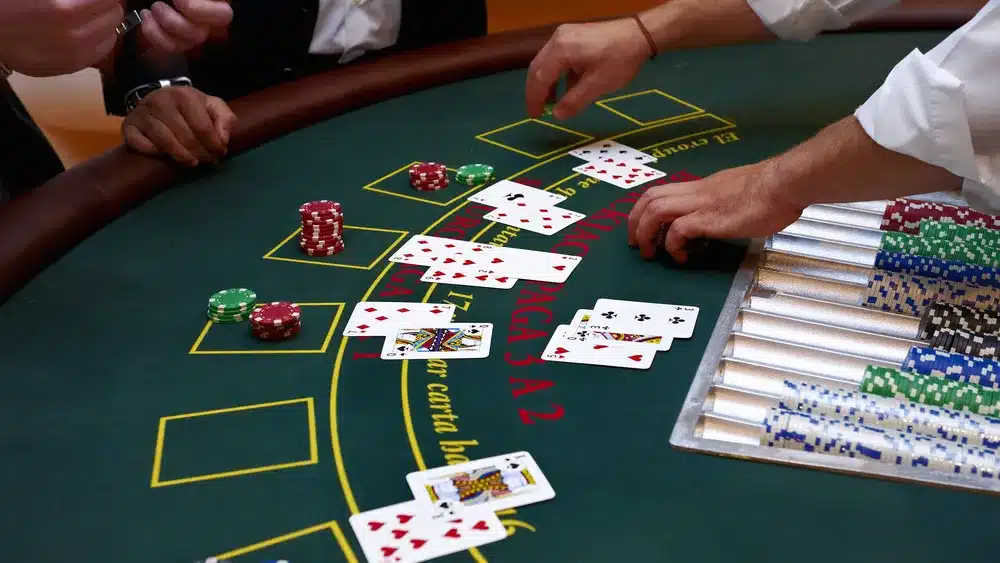Understanding D'Alembert method disadvantages for smarter gameplay The D'Alembert system is one of the most popular betting methods for roulette players who prefer a structured, cautious approach. Its appeal lies in its gradual bet increases, which feel safer than aggressive systems like the Martingale system. However, slow doesn’t always mean safe. Losing streaks, table limits, […]

Outsmart the dealer with the right Blackjack stand timing
Blackjack is a fast-paced game where every move counts. From the moment you’re dealt the first two cards, your choices shape the outcome. Would you take another card, double your bet, or surrender your hand? Each of your decisions matters, but one move that takes the game’s centre stage is stand.
At first glance, standing may seem like a passive choice. After all, you’re not doing anything—but that’s where the power lies. Choosing to stand is a silent tactic. It says you trust your hand, and you’re daring the dealer to catch up.
Mastering the right time to stand is key to stretching your bankroll and your odds. Want to play smarter? This Blackjack stand guide walks you through the ins and outs of the calmest yet smartest move you can make in the game.
What is Blackjack stand? Discover the calm move with a big impact
Think of Blackjack stand as your way of saying, ‘I’m good with my hand.’ It’s a player action where you stop drawing cards and hold onto your current total, with the hopes that it’s strong enough to beat the dealer.
Standing is only one of the five player actions in the game. The other include:
- Hit: Take another card to improve your hand.
- Double down: Double your bet before taking a new card.
- Split: Separate your current pair into two hands. You can play them separately.
- Surrender: If you think your hand is unlikely to win, you can forfeit through surrender.
Among these actions, stand is a crucial one. It’s cautious, yes, but it can also be your most defensive move.
If, say, you’re holding an 18 (10 and 8), you can choose to stand. Hitting with an 18 puts you at risk of pulling a card that could push your hand over 21, which is a bust. When done right, standing can protect your stack and help you ride out risky rounds.
Why standing could be your smartest Blackjack move?
In Blackjack, timing is everything. Knowing exactly when to stand might be the best skill you can sharpen. It’s a player action that helps you avoid the worst outcome in Blackjack: going bust (over 21). The moment your hand exceeds that limit, it’s an instant loss.
On another note, Blackjack can wear you down fast. Every choice is a gamble, and overthinking often leads to mistakes. Standing helps simplify your play and cuts down decision fatigue. It’s a steady move that wins enough to stretch your bankroll and keep you in the game longer.
The game flow: How does standing work in Blackjack?
When you choose to stand in Blackjack, your turn is done. This means the spotlight shifts to the dealer, but what happens next? Understanding this flow helps you see how impactful a stand can be in a Blackjack game.
Here’s a basic flow of play after a stand:
- You receive your cards: Say you’re dealt cards of 10 and 8, which leaves you with a hand of 18.
- You decide to stand: You’re satisfied with 18, so you end your turn with a stand.
- Dealer reveals their hand: After your turn, the dealer reveals a card of 6.
- Dealer must draw: It is a standard house rule that dealers must hit until they reach a hand of 17.
- Dealer draws a 10: After hitting, the dealer received a 10. Their hand now totals 16.
- Dealer draws again: Since their hand is still under 17, they must hit again. After receiving a 7, they now have a hand totalling 23—a bust.
- You win the round: Your 18 beats the dealer’s busted hand.
The dealer’s actions are fixed, as they play based on house rules. You, on the other hand, get to choose how you play. This is why your decision to stand changes everything. Imagine if you hit and get a higher card, you’re busted already.
Blackjack stand rules: The ins and outs of standing in a session
Standing in Blackjack might seem like a simple action, but behind it lies a carefully crafted rule that shifts based on who you are—the player or the dealer. In a nutshell, the player gets freedom, but the dealer? Not so much.
Here’s a quick rundown of Blackjack stand rules—know who can stand, when, and how they can affect the pace and outcome of your session:
Player rules
As a player, you have complete control over when you should stand. You can make that choice as early as your first two cards or even later, after taking one or more hits.
In this game, your moves are entirely up to you. There are no ‘if this, then that’ conditions before you can make an action. This flexibility gives you the power to time your move based on several factors.
Most players choose to stand when they hit a total of 17 and above. This is because the chance of going bust with another card gets much higher from that point onward. Still, the numbers aren’t enough to be your sole tactic when you stand. Your decision must also consider what card the dealer has face-up.
Dealer-only rules
Blackjack dealers play by strict house rules, designed to keep the game fair and square. In most Blackjack games, dealers must hit until they reach a total of 17 or more. It’s often written on the Blackjack table you’re playing in.
The rule seems simple, but there’s a catch—what counts as 17? In the game, there’ll be two types of hands: hard and soft.
- A hard 17 is a hand total that doesn’t have any Ace card counted as 11. For example, a 10 and a 7 is a hard 17.
- On the other hand, a soft 17 includes an Ace counted as 11 in the total hand. Say, Ace and 6 = 17.
Some casinos would still make the dealer hit on soft 17s, while others stand firmly. This difference might sound small, but it has a big impact. When dealers must hit on soft 17, they’re more likely to improve their hand due to having an Ace in hand. This gives the house an extra edge, and it also forces you to adapt your tactics.
Remember: Before you sit down at any Blackjack table, check the rules. Whether you’re playing in person or online, those small house variations can change how you play and when you choose to stand.
On Blackjack stand timing: Know when to say no to more cards
The real strength in Blackjack comes from knowing when to make a move, especially when it comes to standing. Knowing the perfect Blackjack stand timing means knowing which hands to avoid for a better shot at winning. Here are a few scenarios in which you can or cannot stand in a Blackjack session:
When to stand in a Blackjack game?
There are many key moments in Blackjack where standing is your stronger move. These spots often involve high enough hands or dealer weak points that you can use to your benefit:
- Your hand total is 17 or more
Your hand is already solid with these cards. Hitting only risks a bust with very few cards that could improve your chances. Always stand and let the dealer catch up to you.
- You’re holding a total between 13 and 16, and the dealer shows an upcard between 2 and 6
This is one of the most favoured stand scenarios. The dealer’s weak upcard means there’s a good chance they’ll bust, as they will keep on hitting. Don’t help them out by taking another card or going bust.
- Your hand total is 12, while the dealer has either a 4, 5, or 6 upcard
Standing at 12 might feel risky, but the dealer’s upcard puts them in a tight spot. When you stand, you’re giving the dealer more room to make a mistake.
When not to stand in a Blackjack game?
While standing can be powerful, there are moments when you need to keep pushing. If your hand is weak and the dealer looks strong, standing could lock you into a loss. Here are some instances where you should never stand in a Blackjack game:
- The dealer shows high cards
A dealer’s upcard of 7 or higher suggests a strong hand on their end. If you happen to have a total of 12 or below, standing will only be a losing move.
- You have a hand total of 9 or less
With such a low total, your hand has almost no winning power. Take the hit. You won’t bust, and the upside is too good to ignore.
- You’re holding a 10 or a total between 12 and 16
These mid-range hands are risky. A hand of 16 is often regarded as a weak hand, so standing on them when the dealer’s cards are strong will only lead to a loss. Hitting gives you a chance to build a better hand and prolong your session.
Blackjack stand strategy: Turn your casual plays into smarter ones
If you want to stay ahead of the game, you need to play smart. Doing this allows you to use a set of smart Blackjack stand strategy charts to help guide your moves. These charts show you what to do based on your hand and the dealer’s card.
Ready to step up your game? Learn how to read the chart, understand hand types, and follow simple patterns to boost your Blackjack winning odds.
Basic Blackjack strategy chart
Most of the time, deciding when and what timing you should stand is also a challenge. Thankfully, the Blackjack strategy charts are here to serve as your quick reference guides. They tell you when to stand, hit, double down, or split based on calculations. Think of them as your Blackjack compass.
In the tables below, six decks of cards are used as a reference for the actions:
Hard Hand
| Hard Hand(excluding Ace) | Dealer’s Upcard | ||||||||||
| 2 | 3 | 4 | 5 | 6 | 7 | 8 | 9 | 10 | A | ||
| Player’s Hand (Total Value) | 4 to 8 | H | H | H | H | H | H | H | H | H | H |
| 9 | H | DH | DH | DH | DH | H | H | H | H | H | |
| 10 | DH | DH | DH | DH | DH | DH | DH | DH | H | H | |
| 11 | DH | DH | DH | DH | DH | DH | DH | DH | DH | DH | |
| 12 | H | H | S | S | S | H | H | H | H | H | |
| 13 | S | S | S | S | S | H | H | H | H | H | |
| 14 | S | S | S | S | S | H | H | H | H | H | |
| 15 | S | S | S | S | S | H | H | H | RH | RH | |
| 16 | S | S | S | S | S | H | H | RH | RH | RH | |
| 17 | S | S | S | S | S | S | S | S | S | RS | |
| 18+ | S | S | S | S | S | S | S | S | S | S | |
Soft Hand
| Soft Hand(including Ace) | Dealer’s Upcard | ||||||||||
| 2 | 3 | 4 | 5 | 6 | 7 | 8 | 9 | 10 | A | ||
| Player’s Hand | A + 2 | H | H | H | DH | DH | H | H | H | H | H |
| A + 3 | H | H | H | DH | DH | H | H | H | H | H | |
| A + 4 | H | H | DH | DH | DH | H | H | H | H | H | |
| A + 5 | H | H | DH | DH | DH | H | H | H | H | H | |
| A + 6 | H | DH | DH | DH | DH | H | H | H | H | H | |
| A + 7 | DH | DH | DH | DH | DH | S | S | H | H | H | |
| A + 8 | S | S | S | S | DH | S | S | S | S | S | |
| A + 9 | S | S | S | S | S | S | S | S | S | S | |
Pair
| Pair(Same Number) | Dealer’s Upcard | ||||||||||
| 2 | 3 | 4 | 5 | 6 | 7 | 8 | 9 | 10 | A | ||
| Player’s Hand | 2 + 2 | P | P | P | P | P | P | H | H | H | H |
| 3 + 3 | P | P | P | P | P | P | H | H | H | H | |
| 4 + 4 | H | H | H | P | P | H | H | H | H | H | |
| 5 + 5 | D | D | D | D | D | D | D | D | H | H | |
| 6 + 6 | P | P | P | P | P | H | H | H | H | H | |
| 7 + 7 | P | P | P | P | P | P | H | H | H | H | |
| 8 + 8 | P | P | P | P | P | P | P | P | P | P | |
| 9 + 9 | P | P | P | P | P | S | P | P | S | S | |
| 10 + 10 | S | S | S | S | S | S | S | S | S | S | |
| A + A | P | P | P | P | P | P | P | P | P | P | |
Strategy charts explained
Reading the chart is simple, so is following it for your next moves. The table shows what exact action you should take given your current hand and the dealer’s upcard. Here’s a quick breakdown:
- Player’s hand are the cards held by the player.
- Dealer’s upcard is the dealer’s face-up card.
- Hard hand is a hand total that doesn’t include an Ace.
- Soft hand is a hand total including an Ace.
- Pair is a combination of the same number in your hand.
| H | Hit |
| S | Stand |
| D | Double down |
| DH | Double down, but Hit if you can’t |
| DS | Double down, or Stand if you can’t |
| P | Split |
| RH | Surrender, but Hit if you can’t |
| RS | Surrender, or Stand if you can’t |
Not every move is certain. The table also gives you an option to stand or hit in case you can’t do the action at the moment. Say you hold A+6, and the dealer has a 3. The chart shows ‘DH.’ This means double if you can; otherwise, hit.
Other Blackjack strategies
Aside from charts, there are other smart Blackjack strategies to sharpen your game sessions. Check out these Blackjack stand tips and tricks:
Betting systems
These betting systems help manage risk when you’re playing. One example is the Martingale system. You double your bet after each loss, and go back to your initial bet when you win. It’s a tactic to help recover your losses.
You may also try other ones like the Labouchère system, which follows a sequence to decide your bet. You just need to break down your profit goal into smaller chunks and add them bit by bit for the amount. It’s more structured, but needs careful tracking.
There’s also the Fibonacci system that uses the famed Fibonacci sequence (1, 1, 2, 3, 5, 8…). Raise your bets following the pattern in every loss, then step back two numbers after a win. Each system presents pros and cons, but all of them are aimed at helping keep your bankroll in check. Don’t hesitate to explore and find which fits you best.
Make the perfect Blackjack stand and play like a pro at Bitcasino
Smart decisions win Blackjack, and you’ve just learned one of the most crucial ones: when to stand. With this knowledge at hand, it’s time to bring it to the table. Bitcasino offers a wide range of Blackjack games—from standard versions to live dealer tables that bring an immersive experience.
Play with confidence through seamless crypto payments, which allow you to deposit and withdraw funds easily. With provably fair gaming, your sessions are smoother, faster, and more secure. Take your new knowledge, sit at the table, and play like a pro!
Frequently Asked Questions (FAQs)
What does ‘stand’ mean in Blackjack?
In Blackjack, ‘stand’ means choosing to keep your current hand and not draw any cards. This ends your turn, and the dealer continues play.
When should I choose to stand in Blackjack?
You should stand when your hand has a good total, and if the dealer is likely to bust. Best instances include holding a total of 17 or more, while the dealer’s card is weak (e.g., 4 or 5).
What is the difference between ‘hit’ and ‘stand’?
They’re complete opposites. When you ‘hit’, it means you’d get a new card to improve your hand. When you ‘stand’, you’re satisfied with your total and won’t draw more.
Can using a stand strategy help me win when I play Blackjack?
Yes, learning when to stand is a key part of a Blackjack strategy. It helps you avoid going bust, and it forces the dealer into riskier draws.
Recent Post
Self-Hyena method and its strong impact on casino strategy The Self-Hyena method has become a growing topic of discussion in casino strategy circles. Often described as a hybrid approach to betting, it attracts attention as it relies less on pure chance. You are relying more on keen observation, timing, and discipline with the Self-Hyena method, […]
Poker kicker guide: Learn the key rules before you play In poker, knowing the rank of your hand is not enough to judge if you will win. A kicker plays a huge role in close hands where two or more players share the same main rank, such as a pair or two pairs. The poker […]

Actual payout amounts will vary depending on the currency you use.















